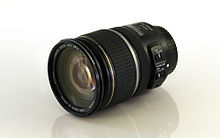Canon EF-S 17–55mm lens
 | |
| Maker | Canon |
|---|---|
| Technical data | |
| Type | Zoom |
| Focal length | 17–55mm |
| Focal length (35mm equiv.) | 27–88mm |
| Crop factor | 1.6 |
| Aperture (max/min) | f/2.8 / f/22 |
| Close focus distance | 0.35 m (1.15 ft) |
| Max. magnification | 0.17 @ 55mm |
| Diaphragm blades | 7 |
| Construction | 19 elements in 12 groups |
| Features | |
| Short back focus | |
| Ultrasonic motor | |
| Lens-based stabilization | |
| Macro capable | |
| Application | Fast standard zoom |
| Physical | |
| Max. length | 110.6 mm (4.4 in) |
| Diameter | 83.5 mm (3.3 in) |
| Weight | 645 g |
| Filter diameter | 77 mm |
| Accessories | |
| Lens hood | EW-83J, optional |
| Case | LP1219, optional |
| Angle of view | |
| Horizontal | 68°40'–23°20' |
| Vertical | 48°–15°40' |
| Diagonal | 78°30'–27°50' |
| History | |
| Introduction | 2006 |
| Retail info | |
| MSRP | $1,179 USD |
The Canon EF-S 17–55mm f/2.8 IS USM is a standard zoom lens for Canon digital single-lens reflex cameras with an EF-S lens mount. The field of view has a 35 mm equivalent focal length of 27–88mm.
Reception
[edit]Praise
[edit]It is praised as "one of the best general/multi-purpose lenses available",[1][2] and ideal for available light photography on a Canon APS-C camera.[3]
The fast f/2.8 aperture, combined with 3-stop image stabilization, makes the 17–55 very useful in low light compared to an unstabilized f/3.5–5.6 Canon EF-S 18–55mm lens, which is a frequent kit lens, and thus the 17–55 is much more suited for hand holding and available-light photography. Newer versions of the 18–55 kit lens include 4-stop image stabilization, but remain slower aperture, partly addressing this concern.
Criticism
[edit]This lens has been criticized by one review as prone to flare when the sun is in the frame.[2]
The 17–55 suffers from vignetting at f/2.8 of 0.5–1 EV throughout the focal range,[3][4] though current Canon bodies are able to correct this by storing the vignetting data within the camera memory.
Chromatic aberration is a relative weakness at the wide end (at the edges and corners),[3] but is quite low for a zoom lens in this range.[4] Barrel distortion is evident at the wide end.[4]
Some users have reported dust gathering inside the lens.[2]
Quality
[edit]The 17–55mm is not an L-series lens, but it has two UD (ultra-low dispersion) lens elements, which are largely reserved for L-series lenses, and some say that the 17–55 has comparable image quality to L-series lenses.[2][4] Some regard the decision to not designate the lens as L-class as marketing-driven,[4] but being EF-S it will not fit on a full-frame body—therefore, at least under current Canon marketing strategy, cannot be labeled L-series.
"The resolution figures are among the very best seen so far for an APS-C standard zoom lens."[4]
The build quality is inferior to L-series lenses (plastic body, not magnesium alloy), though superior to the EF-S 17–85mm lens.
Similar lenses
[edit]Unlike most other EF-S lenses, the 17–55mm does not have a direct equivalent in the range of traditional EF lenses. As a general purpose EF-S zoom lens, the alternatives to the 17–55mm are the EF-S 18–55mm f/3.5–5.6, which is a cheaper kit lens; the EF-S 17–85mm f/4–5.6 IS USM, which is midway between the 18–55mm and 17–55mm in some respects – depending on which version of the 18–55 one is comparing – and boasts a longer telephoto end; and the newer EF-S 15–85mm f/3.5–5.6 IS USM, which has similar build quality to the 17–55mm and the largest focal length range of the group.
The 17–55 is at times compared to the EF 17–40mm f/4L USM, which has similar image quality (despite the latter being L series and the 17–55 not being so designated), though the 17–55's faster aperture and IS make it more suited (by one stop) for hand-holding and available light photography. Also, it can be compared to the three Canon EF 24–70 mm L lenses. Two of the 24–70 lenses have the same f/2.8 maximum aperture as the 17–55, but no image stabilization; the newest 24–70 has a maximum f/4 aperture but adds stabilization. When mounted on their equivalent cameras (full-frame for the 24–70, and crop for the 17–55), the two lenses have similar focal lengths. The IS system of the 17–55 gives that lens an advantage over the 24–70 f/2.8 in lower light by reducing the amount of camera shake. The 17–55 and the 24–70 f/4 are both stabilized, but the 17–55 has a one-stop advantage over that version of the 24–70.
The EF 28–90mm, though having corresponding full-frame equivalent focal length, is an inexpensive kit lens and is not comparable to the 17–55mm, having slower aperture, a variable maximum aperture, lower image quality, and no image stabilization.
References
[edit]- ^ Greenspun, Philip. "Canon EF-S 17–55/2.8 IS USM Review". Photo.net. Archived from the original on 26 July 2009. Retrieved 25 February 2008.
- ^ a b c d Carnathan, Bryan. "Canon EF-S 17–55mm f/2.8 IS USM Lens Review". The-Digital-Picture.com. Retrieved 25 February 2008.
- ^ a b c "Canon EF-S 17–55mm f/2.8 IS USM". Imaging-Resource.com. Retrieved 9 July 2020.
- ^ a b c d e f "Canon EF-S 17-55mm f/2.8 USM IS – Test Report / Review". photozone. Retrieved 25 February 2008.
